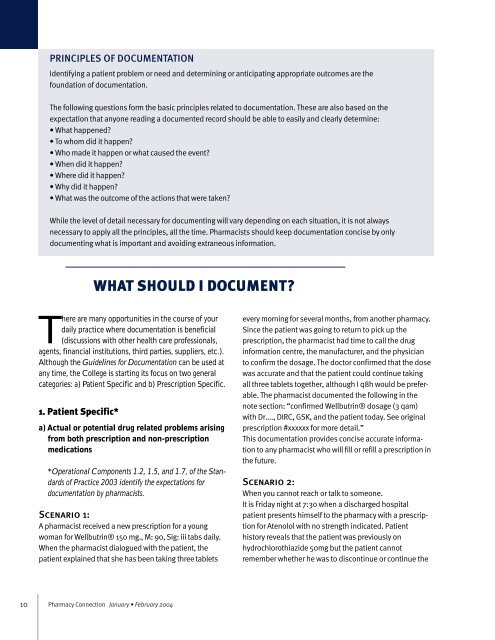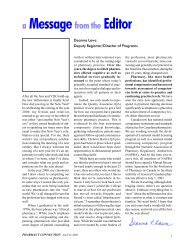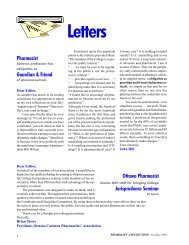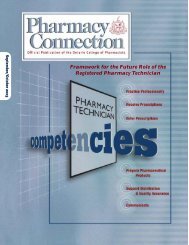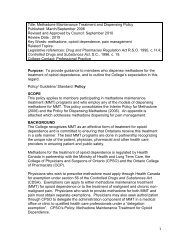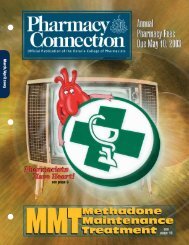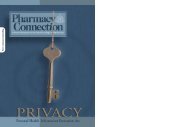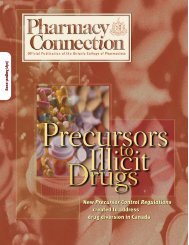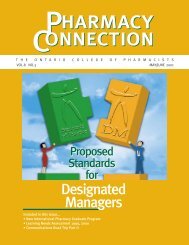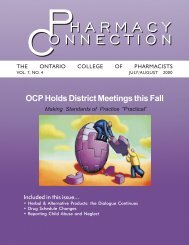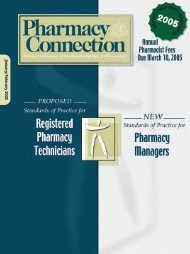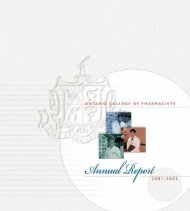January/February 2004 - Ontario College of Pharmacists
January/February 2004 - Ontario College of Pharmacists
January/February 2004 - Ontario College of Pharmacists
Create successful ePaper yourself
Turn your PDF publications into a flip-book with our unique Google optimized e-Paper software.
PRINCIPLES OF DOCUMENTATION<br />
Identifying a patient problem or need and determining or anticipating appropriate outcomes are the<br />
foundation <strong>of</strong> documentation.<br />
The following questions form the basic principles related to documentation. These are also based on the<br />
expectation that anyone reading a documented record should be able to easily and clearly determine:<br />
• What happened?<br />
• To whom did it happen?<br />
• Who made it happen or what caused the event?<br />
• When did it happen?<br />
• Where did it happen?<br />
• Why did it happen?<br />
• What was the outcome <strong>of</strong> the actions that were taken?<br />
While the level <strong>of</strong> detail necessary for documenting will vary depending on each situation, it is not always<br />
necessary to apply all the principles, all the time. <strong>Pharmacists</strong> should keep documentation concise by only<br />
documenting what is important and avoiding extraneous information.<br />
WHAT SHOULD I DOCUMENT?<br />
There are many opportunities in the course <strong>of</strong> your<br />
daily practice where documentation is beneficial<br />
(discussions with other health care pr<strong>of</strong>essionals,<br />
agents, financial institutions, third parties, suppliers, etc.).<br />
Although the Guidelines for Documentation can be used at<br />
any time, the <strong>College</strong> is starting its focus on two general<br />
categories: a) Patient Specific and b) Prescription Specific.<br />
1. Patient Specific*<br />
a) Actual or potential drug related problems arising<br />
from both prescription and non-prescription<br />
medications<br />
*Operational Components 1.2, 1.5, and 1.7, <strong>of</strong> the Standards<br />
<strong>of</strong> Practice 2003 identify the expectations for<br />
documentation by pharmacists.<br />
Scenario 1:<br />
A pharmacist received a new prescription for a young<br />
woman for Wellbutrin® 150 mg., M: 90, Sig: iii tabs daily.<br />
When the pharmacist dialogued with the patient, the<br />
patient explained that she has been taking three tablets<br />
every morning for several months, from another pharmacy.<br />
Since the patient was going to return to pick up the<br />
prescription, the pharmacist had time to call the drug<br />
information centre, the manufacturer, and the physician<br />
to confirm the dosage. The doctor confirmed that the dose<br />
was accurate and that the patient could continue taking<br />
all three tablets together, although I q8h would be preferable.<br />
The pharmacist documented the following in the<br />
note section: “confirmed Wellbutrin® dosage (3 qam)<br />
with Dr…., DIRC, GSK, and the patient today. See original<br />
prescription #xxxxxx for more detail.”<br />
This documentation provides concise accurate information<br />
to any pharmacist who will fill or refill a prescription in<br />
the future.<br />
Scenario 2:<br />
When you cannot reach or talk to someone.<br />
It is Friday night at 7:30 when a discharged hospital<br />
patient presents himself to the pharmacy with a prescription<br />
for Atenolol with no strength indicated. Patient<br />
history reveals that the patient was previously on<br />
hydrochlorothiazide 50mg but the patient cannot<br />
remember whether he was to discontinue or continue the<br />
10<br />
Pharmacy Connection <strong>January</strong> • <strong>February</strong> <strong>2004</strong>


